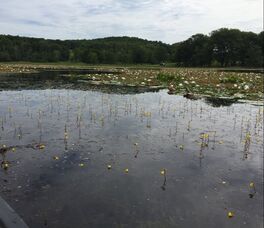CONSERVATION CORNER
A weekly blog for all things conservation
 By: Tess Flynn-Belles, Natural Resource Specialist During the growing season, the Conservation District can anticipate receiving several calls from landowners who own ponds asking how to control and treat aquatic plants. There are many options to consider, but the first question that needs to be addressed is, “What plant species are you trying to treat?”. The method of treatment will vary on what plant species you are targeting. In this article, we will briefly discuss the three basic methods of treatment (biological, chemical and physical) and some pros and cons of each. The biological method is the most “natural” and less physically demanding option, although it may take more time to see results. I’m sure many people have heard of grass carp as an option for managing plants in their pond. This is one example of biological control strategies. Triploid grass carp are a non-native (but sterile, meaning they shouldn’t be able to reproduce), plant eating fish that some landowners may stock in their ponds to control aquatic plant growth. There are a few important things (good and bad) to consider when stocking grass carp, so please consult the Conservation District or the Fish and Boat Commission (permits required). Another example of biological control method are product additives that contain microbes or enzymes that feed on or consume nutrients, like nitrogen and phosphorus, making them less available for plant and algae growth.
When it appears that plant and algae growth has reached a nuisance level, it might be time to consider an appropriate chemical control strategy. Aquatic herbicides fall into two categories, contact and systemic, and usually provide a quick solution to the problem. As the name entails, contact herbicides must directly touch the plant to be effective and will only kill the area of the plant that is treated. Systemic herbicides are absorbed through the leaves and roots and then transported throughout the entire plant. Using the chemical method, plants will most likely need to be treated for a few consecutive years to keep them under control and this can become costly. It is also very important the applicator read all directions on the labels before treatment. A permit is also required by DEP any time an aquatic herbicide is used (currently, the permit is free). For small pond owners, physical harvesting of aquatic plants and algae can be very effective. It can be labor intensive and time consuming, but there are no permits required and, if done properly, it will prevent extra nutrients from the decaying plants to be released into the water column. If you are pulling, raking, or cutting the target plant, proper identification of the plant should be done before removal. Some plant species reproduce by fragmentation or the breaking up of the plant, so any of these techniques could cause further spread of the plant. Drawdown of the pond is another method that some owners use in the winter months. Usually, this method is used to target unwanted plants around the edges and in the shallow areas of the pond by freezing bottom sediments. This was just a very quick and basic overview of some of the different methods of aquatic plant management. Again, the first thing landowners so do is make sure that they properly identify the plant species that they want to treat. If you would like more detail on any of these methods, please reach out to the Conservation District staff and we can discuss options. Lastly, on a completely different note, we have a Forestry Symposium this Friday at the Wysox Fire Hall from 9:30-3:00. The Symposium will provide forestry education to forest landowners and forest industry professionals to continue and expand knowledge and understanding of forestry practices, selection, sustainability, and forest health through forestry presentations and a Guided Forestry Tour. The tour will be after the meeting, for those who wish to participate, 3-5:00 pm.
0 Comments
Leave a Reply. |
AuthorsVarious staff at the Bradford County Conservation District Archives
July 2024
Categories
All
|
|
Bradford County Conservation District
Stoll Natural Resource Center 200 Lake Road, Suite E | Towanda PA 18848 Phone: (570)-485-3144 |
